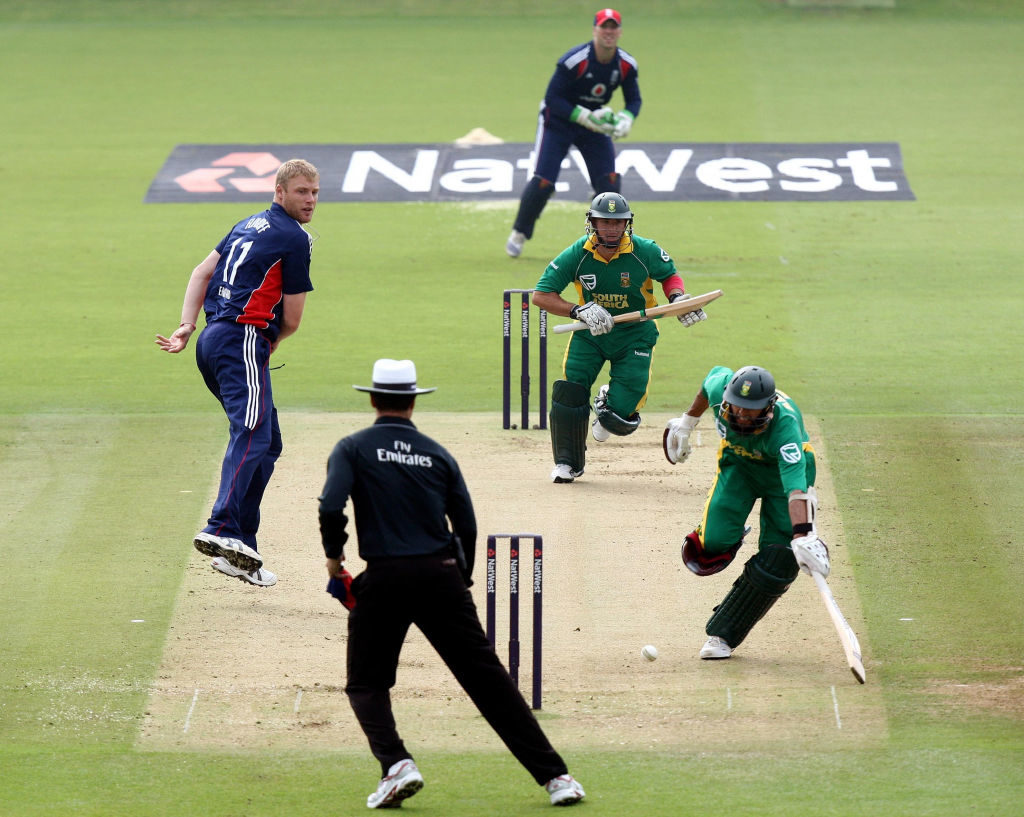Proteas legend Herschelle Gibbs has shared some strong words about the Proteas’ batting approach in the first ODI at St George’s Park, where South Africa lost by five wickets, writes SIMON LEWIS.
Gibbs pointed out that in the era of T20 cricket, he was surprised to see an ODI scorecard where only two wickets fell in the innings, without the batsmen significantly upping the scoring rate over the last 10 overs. Hashim Amla received particular scrutiny for not pulling the trigger en route to his 27th ton, the opener scoring 108 not out off 120 balls as the Proteas posted a total of 266 off their 50 overs … but with eight wickets in hand.
David Miller only faced a handful of balls while big-hitting Faf du Plessis and Heinrich Klaasen didn’t even get on the park, a fact which drew widespread criticism from cricket fans around South Africa. The majority of fans believed there was no excuse for the batsmen not managing to accelerate the run rate to get the Proteas past the 300-run mark at St George’s Park.
#SSCricket Never thought id see this stat esp with the t20 revolution pic.twitter.com/oUkhhGdgAu
— Herschelle Gibbs (@hershybru) January 19, 2019
The total scored by the Proteas was the lowest ODI total since 1992 from a side that was two wickets down after batting first. Gibbs was critical of the Proteas’ approach, and in particular of Amla’s performance.
When both batsmen are in and set after 30-35 over overs which they both clearly were..the senior player takes the initiative and make the play..he’s made 26 ? before and his supporters think it’s ok with a 90% strike rate for 50 overs.shows how much they actually know?
— Herschelle Gibbs (@hershybru) January 21, 2019
Gibbs also stressed that, with David Miller in the lineup, perhaps a wicket could have been sacrificed to get the left-handed danger man to the crease sooner. With hindsight, Miller’s appearance earlier in the innings could certainly have swung the balance the Proteas’ way.
Not sure how both batsman can have the same approach for so long..one should pulled the trigger ages ago.#SSCricket
— Herschelle Gibbs (@hershybru) January 19, 2019
Gibbs also highlighted some interesting thoughts on the selection of the Proteas side which he felt impacted on the Proteas’ chances in the match.
‘We lack the variety of a left-arm pacer, we have a spinner, yes. As a batsman in the opposition it’s easier to prepare, knowing you only have right-arm bowlers to face the majority of the time. Never mind trying different batsmen,’ tweeted Gibbs.
The decision to rest Quinton de Kock for two ODIs off the back of his century in the third Test was another topic on which Gibbs shared his thoughts.
‘All the Tests were done in 3 days, so he had plenty days off … keep the form going, the World Cup is a few months away,’ Gibbs said to his 574,000 Twitter followers.
A dashing stroke player throughout his career, Gibbs played one of the great ODI innings to lead South Africa to an improbable victory over Australia at the Wanderers on 12 March 2006 in the so-called ‘438’ match. Gibbs scored an epic 175 runs off just 111 balls that day (S/R 157.65), with 21 fours and seven sixes in a sensational victory which has been widely acknowledged as the greatest ODI ever played.
Amla made his ODI debut almost exactly two years after the 438 match, scoring nine not out against Bangladesh on 9 March 2008 in an easy 9-wicket win over Bangladesh. Amla passed Gibbs (who had scored 57 off 84 balls, S/R 67.85) on his way to joining Graeme Smith (103 off 118 balls) to knock off the handful of runs required for the win.
READ ALSO: The upsides of ODI loss to Pakistan
In defence of Amla and Van der Dussen, only on 10 occasions has the St George’s Park pitch offered up a higher score than the 267-7 Pakistan scored to win in the last over on 19 January. The 10th highest score on the list was recorded by the Proteas themselves in 2005 when they chased down England’s score of 267-8 … shades of 2019!
The Proteas scored 270-7 that day, and while it’s wrong to compare different scorecards from different decades, it is interesting to note that the Proteas also (like Pakistan in the first ODI in 2019) scored the winning runs off the first ball of the last over. Perhaps even more interesting to note is that Graeme Smith’s 105 that day came off 131 balls (S/R 80.15), while Gibbs added a valuable 50 off 60 balls (S/R 83.33).
Name a cricket match that still gives you goosebumps.#WhatWeRemember The 438 ODI https://t.co/AfzbVZ73Kc pic.twitter.com/dhoLcnz0yY
— ESPNcricinfo (@ESPNcricinfo) December 25, 2018
Pakistan clearly enjoy the conditions in Port Elizabeth as they have recorded the highest ODI score at the ground, a massive 335-6 on 11 December 2002. In that match, Gibbs scored 40 off 30 balls (S/R 133.33) as the Proteas were bundled out for 153 in 29 overs – although, at that run rate, if they had wickets in hand they might have been able to push Pakistan for the win.
Two matches before the 438 run-fest at the Wanderers, the Proteas lost the third ODI to Australia at St George’s Park by 24 runs. South Africa were bowled out for 230 off 47.2 overs that day … AB de Villiers scoring 68 off 92 balls (S/R 73.91), Shaun Pollock 69 off 74 balls (S/R 73.91) and Gibbs 16 off 30 balls (S/R 53.33).
READ ALSO: Proteas need to adapt – Faf
All things considered, Amla’s 108 not out off 120 balls (S/R 90.00) and Van der Dussen’s 93 off 101 balls (S/R 92.07) don’t seem so bad after all. St George’s Park is not the Wanderers when it comes to scoring big runs quickly!
Gibbs’ comments should, of course, be considered in context of his original statement that this is the age of T20 cricket, and quite correctly, it was somewhat unusual that neither of the batsmen sacrificed their wickets, as that would have offered the middle order more time to strike at Pakistan.
However, in the broader scheme of things (and in the lead-up to the World Cup in England), I would far rather suffer one ODI loss, but have Amla and Van der Dussen find form rather than rack up just another forgettable ODI win in ‘yet another ODI series’.
I liked a @YouTube video https://t.co/A5buQC76Cv World Record Score Chase 438 in Cricket History Ever – Cricket Highlights
— Manish Pal (@Manish00996) January 21, 2019
During his 248-ODI career Gibbs scored 8094 runs at a strike rate of 83.26 (ave 36.13), including 21 centuries. Amla has now scored 27 ODI tons in 170 ODIs, totalling 7804 runs at a strike rate of 89.31 (ave 50.34). Times have changed, bowlers have changed, rules have changed, field-restrictions have changed and even hairlines have changed, so accurate comparisons are hard to make.
One thing I know for sure, however, is that South African cricket fans have been truly blessed to have had two such incredible cricketers to support over the past 23 years – Herschelle Gibbs and Hashim Amla.
Photo: David Davies – PA Images/PA Images via Getty Images







